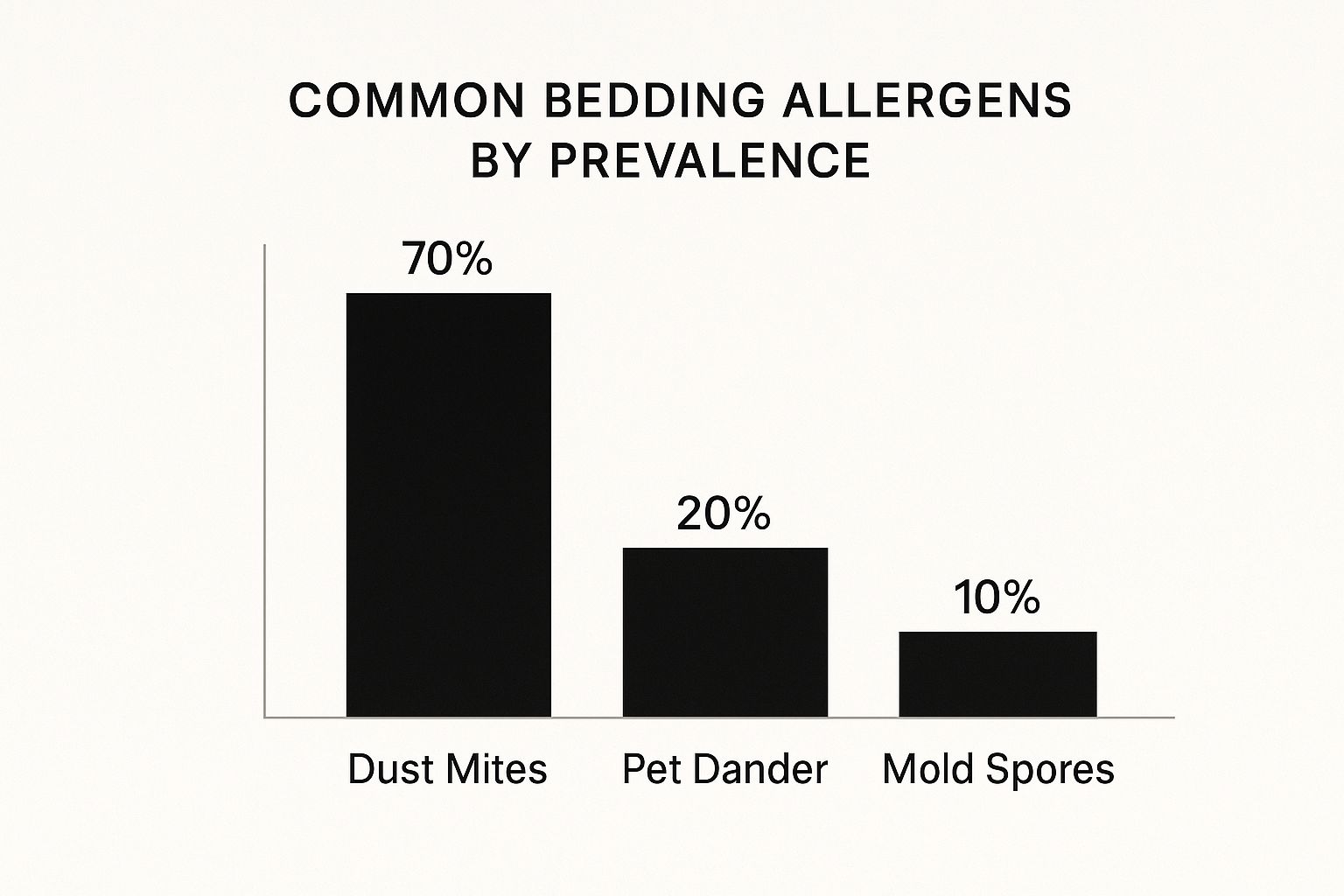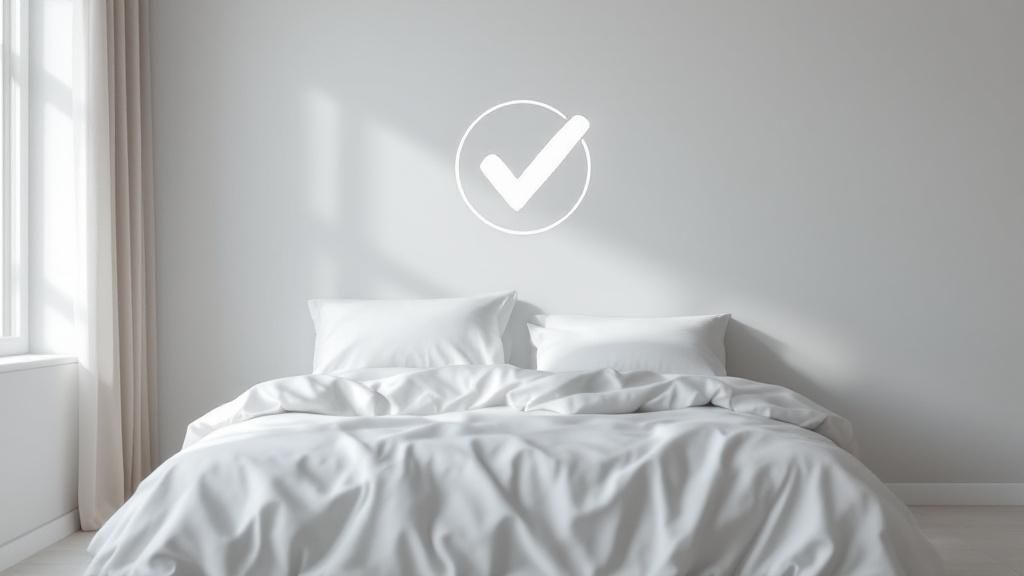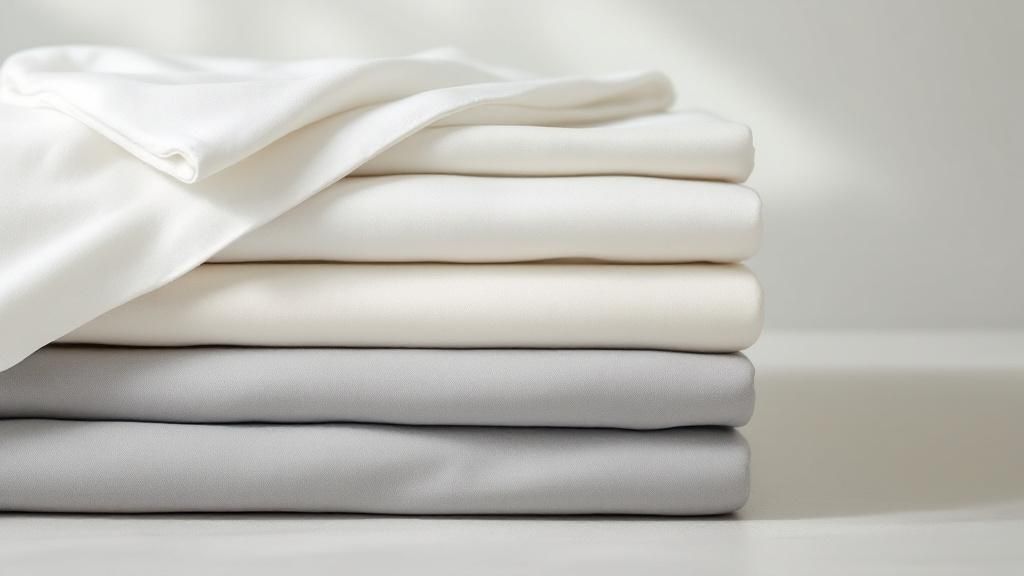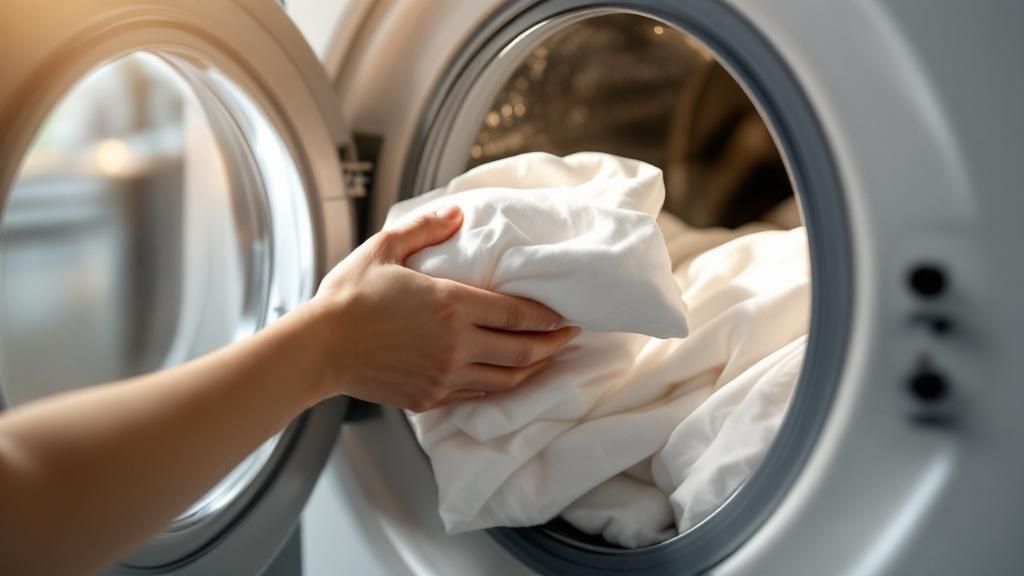If you're constantly waking up congested, the problem might be closer than you think—it could be your bedsheets. The best sheets for allergies are typically made from materials with a naturally tight weave and antimicrobial properties. Think bamboo, silk, or even high-quality microfiber. These fabrics create a protective barrier, making it much harder for common allergens to settle in and multiply.
Your Guide to Allergy-Free Bedding
Waking up with itchy eyes, a runny nose, or a fit of sneezing can ruin your day before it even begins. While a lot of things can trigger allergies, your bedding is often a major, overlooked culprit. Many common sheet materials can become a breeding ground for microscopic irritants that thrive in the warmth and fibers of your bed.
So, what are we really up against? Understanding the main offenders lurking between your sheets is the first step toward finding relief.
- Dust Mites: These are the number one indoor allergen. They’re microscopic critters that feed on dead skin cells and love warm, humid environments—like your bed.
- Pet Dander: Even if your furry friend isn’t allowed on the bed, their dander is light and travels easily through the air, getting trapped in sheet fibers.
- Mold and Mildew: These fungi flourish in moisture. Bedding that isn't breathable or good at wicking away sweat can quickly become a haven for them.
This chart really puts the problem into perspective, showing just how common each of these allergens is in the average bed.

As you can see, dust mites are responsible for a staggering 70% of bedding-related allergies. That makes them the primary target you want to eliminate.
Choosing hypoallergenic sheets isn't just about avoiding a stuffy nose; it’s about creating a true sanctuary for restorative sleep. Swapping your sheets for a material designed to combat these triggers can make a world of difference.
Top Hypoallergenic Sheet Materials at a Glance
To help you narrow down the options, here's a quick look at some of the most effective materials for keeping allergens at bay. Each has its own unique strengths.
| Material | Primary Benefit | Best For |
|---|---|---|
| Bamboo | Naturally antimicrobial and moisture-wicking | Hot sleepers and those with dust mite allergies |
| Silk | Naturally repels dust mites; gentle on skin | People with sensitive skin or chemical sensitivities |
| Microfiber | Tightly woven synthetic fibers trap allergens | Budget-conscious shoppers who need a durable option |
| Tencel | Extremely breathable and inhibits bacterial growth | Eco-conscious individuals who prioritize softness |
These materials are all fantastic choices, but they solve the problem in slightly different ways. The right one for you depends on your specific allergies, budget, and sleep preferences.
For instance, bamboo fabric is widely celebrated for its natural resistance to both dust mites and mold, thanks to its moisture-wicking properties. If you want to dive deeper, you can learn more about the specific benefits of bamboo sheets in our detailed guide. This article will help lay the groundwork for choosing the perfect allergy-friendly set for your home.
What's Really Lurking in Your Bed Linens?

To win the battle against those frustrating nightly sniffles, you have to know what you’re up against. Your bed might feel like a safe haven, but to microscopic allergens, it’s a five-star resort. These unwelcome guests are often the real reason so many of us wake up feeling worse than when we went to bed.
The main offender? Dust mites. These tiny creatures, completely invisible to the naked eye, love the warm, humid environment your bedding provides. They feed on the dead skin cells we all naturally shed, and it's actually their waste—not the mites themselves—that triggers most allergic reactions.
A typical used mattress can house anywhere from 100,000 to 10 million mites. Considering we spend a third of our lives in bed, that's a massive amount of exposure.
This is exactly why finding the best sheets for allergies isn't just a luxury; it's about creating a crucial barrier between you and this common trigger.
It’s Not Just Dust Mites
While dust mites get most of the attention, they’re not the only irritants sharing your bed. The very fibers of your bedding are perfect for trapping all sorts of particles, creating a potent mix of allergens.
Here are a few other culprits you’re probably sleeping with:
- Pet Dander: Even if your pets stay out of the bedroom, their dander is incredibly lightweight and travels through the air. It easily settles deep into the fabric of your sheets, blankets, and pillows.
- Mold and Mildew: These fungi thrive on moisture. If your sheets don't wick away sweat effectively, they create the damp environment mold needs to grow, releasing spores that can irritate your respiratory system.
- Pollen: Pollen from the outdoors doesn't just stay outside. It hitches a ride on your hair, skin, and clothing, and gets transferred directly onto your pillowcase and sheets the moment you lie down.
Each of these allergens can contribute to that nightly assault on your immune system. This is why certain fabrics—especially those with a tight weave and moisture-wicking properties—are so much better for people with allergies. They physically block and discourage the growth of these microscopic invaders, helping you build a cleaner, healthier place to rest.
What Are the Best Materials for Hypoallergenic Bedding?

When you see "hypoallergenic" on a package of sheets, it's easy to assume it's a magic bullet for allergies. But what does that really mean? In practice, it means the material is less likely to cause an allergic reaction. It's not a guarantee, but a huge step in the right direction. The key is to understand which fabrics naturally combat the things that make you sneeze and itch.
This isn't just a niche concern anymore. People are waking up to the connection between their bedding and their health. The market for organic bedding—which includes some of the best hypoallergenic options—is expected to skyrocket from USD 531.3 million to USD 942.0 million by 2033. That’s a massive shift, showing just how many of us are looking for a cleaner, healthier night's sleep.
So, let's get into the fabrics themselves and see what makes them stand out.
Organic Cotton
You can't go wrong with this classic. Organic cotton is a go-to for sensitive skin because it's grown without the harsh pesticides and chemicals that can cause irritation. It's also incredibly breathable, which helps prevent moisture from building up—a key factor in stopping mold and mildew before they start.
The only thing to watch for is the weave. A looser cotton weave might still let tiny dust mites through. If mites are your main enemy, look for a high-quality, tightly woven percale or sateen.
My Two Cents: Always look for a GOTS (Global Organic Textile Standard) certification. This is your assurance that the entire process, from farm to finished fabric, is free from nasty chemicals.
Bamboo Viscose
For my money, bamboo is one of the top contenders for allergy sufferers. It's naturally antimicrobial and phenomenal at wicking away moisture. By pulling sweat away from your skin, it keeps your bed dry and cool, making it a terrible place for dust mites and mold to thrive.
- What I love: It has a silky-soft feel, keeps you cool all night, and is a fortress against common allergens.
- Keep in mind: It often costs a bit more and needs gentle care—think cold washes and low-heat drying—to keep it in top shape.
The blend of luxurious comfort and powerful allergy resistance is why so many people swear by it. To see if it's the right fit for you, check out this https://bamtekhome.com/blogs/best-hypoallergenic-bedding guide.
Silk and Microfiber
Silk is the ultimate luxury option. This natural protein fiber has a super smooth surface that simply repels dust mites and other allergens. It feels incredible on the skin and is a true hypoallergenic powerhouse. The downside? The price tag is high, and you have to be very careful when washing it.
At the other end of the price spectrum, you have microfiber. These synthetic sheets are woven with incredibly fine threads, creating a tight physical barrier that traps allergens like dust, pollen, and pet dander. When you wash them, the allergens wash right out. Just a quick tip: steer clear of "brushed" microfiber, as that soft, fuzzy finish can actually trap the very particles you're trying to avoid.
Smart Shopping for Allergy-Friendly Sheets
Choosing the right material is a great first step, but the real secret to keeping allergens at bay is hidden in the finer details. To truly allergy-proof your bed, you need to look past the marketing claims and understand what makes a set of sheets an effective barrier against irritants.
It all starts with the weave of the fabric. Think of it this way: the tighter the threads are woven together, the harder it is for microscopic culprits like dust mites and pet dander to pass through. A dense weave is your first line of defense.
- Percale Weave: This classic grid-like weave feels crisp and cool to the touch. More importantly, its tight construction makes it an excellent shield against allergens.
- Sateen Weave: If you prefer a silkier, more luxurious feel, sateen is a fantastic option. It’s also woven very tightly, providing solid protection while feeling incredibly soft on sensitive skin.
Both percale and sateen weaves leave very little space for allergens to settle in, making them smart choices for anyone prone to sniffles and sneezes.
What to Look For on the Label
Beyond the fabric's construction, certain certifications are your best friend. These labels are a guarantee that the sheets are free from harmful chemicals and residues left over from the manufacturing process, which can often be a source of irritation.
When you're comparing options, look for labels like OEKO-TEX STANDARD 100 or GOTS (Global Organic Textile Standard). These aren't just buzzwords; they're your assurance that every single component, from the thread to the dyes, has been rigorously tested for harmful substances.
As more people prioritize their health, the demand for safer bedding has skyrocketed. This trend is especially noticeable in North America and Europe, where anti-mite bedding has become a major market segment. You can learn more about the growth of this market and the companies leading the charge. By seeking out these certifications, you’re not just buying a marketing promise—you’re investing in proven quality.
Keeping Your Sheets Clean and Allergen-Free

Choosing the right hypoallergenic sheets is a great first step, but the real magic happens in the laundry room. To keep your bed a true sanctuary from sniffles and sneezes, you need a solid cleaning routine. It's the most effective way to ensure your sheets keep protecting you, night after night.
The biggest factor here is consistency. Make a habit of washing your bedding at least once a week. This simple schedule is your best defense against the buildup of skin cells, dust mites, and other irritants that can trigger your allergies.
The Right Way to Wash and Dry
When laundry day rolls around, water temperature is your secret weapon. Washing in hot water—we're talking at least 130°F (54°C)—is incredibly effective at killing dust mites and washing away their waste. Just be sure to double-check the care label on your sheets first, as some delicate fabrics might have different needs.
What you wash your sheets with is just as important as how you wash them.
- Pick a Gentle Detergent: I always recommend a liquid detergent that is both dye-free and fragrance-free. Powdered versions can sometimes leave behind a fine residue, which is the last thing sensitive skin needs.
- Dry Them Completely: After the wash cycle, tumble dry your sheets on a low or medium heat setting. The key is to make sure they are 100% dry before they go back on the bed. Even a little dampness can create a welcome home for mold and mildew.
A proper laundry routine does more than just clean; it actively resets your bedding's defenses. It removes the allergens that have accumulated and ensures your hypoallergenic sheets can do their job effectively night after night.
Following these simple tips will go a long way in maintaining the quality of your sheets and making your bedroom a healthier space. For more detailed instructions on specific materials, take a look at our guide on https://bamtekhome.com/blogs/how-to-care-for-your-bamboo-sheets.
Got Questions About Hypoallergenic Bedding? We've Got Answers.
When you start digging into hypoallergenic bedding, a bunch of questions usually pop up. It makes sense—you want to get it right for a truly restful, sneeze-free night. Let's clear up some of the most common things people wonder about.
First, let's talk terminology. People often use "hypoallergenic" and "anti-allergy" interchangeably, but they're not quite the same. Think of hypoallergenic as being made from materials that are naturally less likely to irritate you, like bamboo or silk. Anti-allergy, on the other hand, means the bedding is actively designed to fight off allergens—maybe it has a super-tight weave to block dust mites or has been treated to prevent their growth.
Does a Higher Thread Count Really Matter for Allergies?
This is a classic one. We've been trained to think higher thread count is always better, but for allergy sufferers, it's a bit more nuanced. Sure, a really high thread count can create a tighter fabric barrier that dust mites struggle to get through, but that's not the whole story.
A thread count between 200 and 700 is often the sweet spot. If you go much higher, the fabric can become less breathable, trapping heat and moisture. That can actually create a cozy environment for mold and mildew to grow, which is the last thing you want.
The real secret isn't chasing a sky-high thread count. It’s about the material itself. A fabric like bamboo or tightly woven organic cotton will do far more to keep allergens at bay than just the number on the package.
Even the best bedding won't last forever. To keep your bed a true sanctuary, it's a good idea to replace your sheets and pillowcases every two to three years. Over time, fibers break down and allergens can build up in ways that even regular washing can't completely solve.
For the ultimate allergy-proof setup, you'll want to look beyond just your sheets. I always recommend a two-pronged defense:
- Mattress Encasements: These are non-negotiable. They zip around your entire mattress, creating a fortress that dust mites and other allergens simply can't penetrate.
- Pillow Protectors: They do the same job as mattress encasements but for your pillows, protecting them from allergens, sweat, and oils that can accumulate night after night.
It’s clear that people are paying more attention to what they sleep on. The global home bedding market was valued at an impressive USD 119.39 billion and is expected to more than double by 2035. This boom is largely fueled by a growing awareness of health and a strong consumer preference for allergy-friendly materials. You can dive deeper into the home bedding market trends to see just how much this space is evolving.
Ready to turn your bed into an allergy-free zone? Experience the difference with Bamtek's silky-soft, 100% organic bamboo sheets. They're naturally hypoallergenic and incredibly comfortable.










